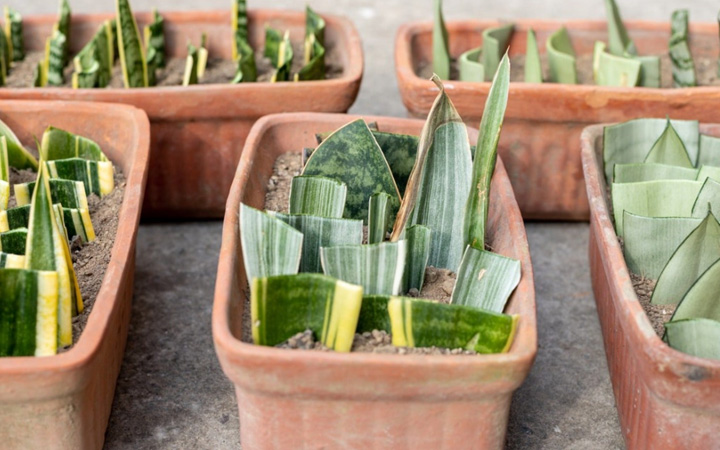Cut off a healthy section of stem, leaf, cane, or branch from a plant; use this plant piece to start a new plant.
Stem Cuttings: Use a sharp, clean scissors or razor blade to cut a 4”-6” piece from the end of a healthy stem just below a leaf node. A node is where a leaf joins the stem. Remove leaves from the bottom 1/3 of the stem. Dip the cut end of the stem into a small amount of Rooting Hormone that contains a Fungicide. Plant the stem in a 4″pot (drip holes in the bottom) of moist potting soil. Cover the pot with clear plastic to increase the humidity and prevent the soil from drying out. Check the plant every few days to be sure the soil stays moist. Tug on the stem cuttings after a few weeks, if there is resistance, roots have developed, the plastic can be removed, and the propagation was successful.
Leaf Cuttings: Remove a mature, healthy leaf from an actively growing stem. Dip the cut end of the leaf into a small amount of Rooting Hormone that contains a Fungicide. Plant the bottom 1/3 of the leaf into moist potting soil. Long leaves, like those of a Sansevieria Plant can be cut into sections. Cover the pot with clear plastic to increase the humidity and prevent the soil from drying out. New plants will grow around the base of the mature leaf.
Cane Cuttings: This propagation method is used when a plant has bare canes with just a few leaves at the top. Cut a 10”-12” piece of cane into 3”-4” sections. Each section should have one or two plant nodes. Dip the cut end of the cane into a small amount of Rooting Hormone that contains a Fungicide. Lay the sections horizontally in soil with the node facing up; alternatively, the cane section can be planted vertically with the node buried in the soil. Cover the pot with clear plastic to increase the humidity and prevent the soil from drying out.
Branch Cuttings: This technique is used for trees with long woody branches. Cut off a 10”-12” healthy branch, about 1/4″ thick that has 4-6 plant nodes on it. Remove any side branches and all but 2 or 3 leaves at the top. Plant the branch in sterile sand or perlite. Cover the pot with plastic, keep the soil moist, and place it in a warm bright location. Tug on the branch cuttings after a few weeks, if there is resistance, roots have developed, the plastic can be removed, and the propagation was successful.

